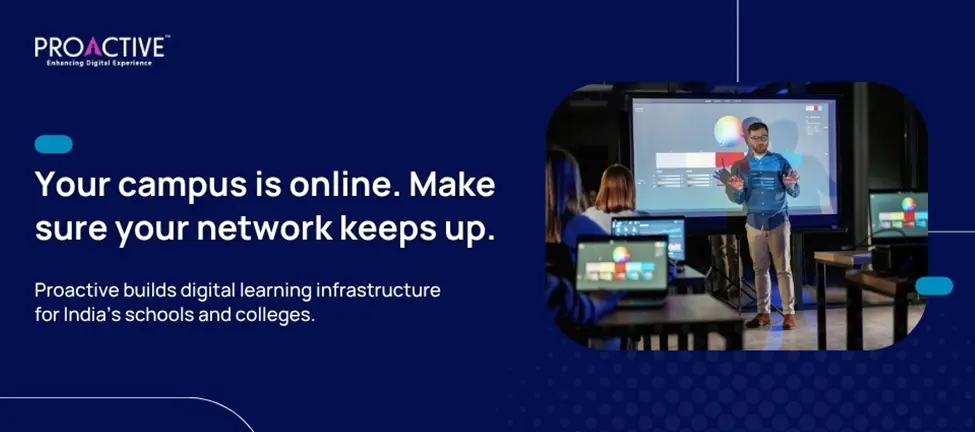Updated: July 18, 2025

The Wi-Fi Bell Has Rung
Chalkboards have been replaced, but the cables haven’t. Across India, from Indore to Kochi, schools and colleges are investing in smart classrooms, cloud-hosted learning tools, and surveillance systems. Yet many still run on fragmented networks built a decade ago. The result is stalled downloads, unsecured guest access, and spiralling maintenance requests.
The future of education will not arrive through fibre alone. It demands design.
What a Smart Campus Actually Requires
Digital learning is more than Zoom and YouTube. It spans learning management systems, biometric attendance, e-books, remote parent-teacher interactions, digital libraries, hostel surveillance, and AI-assisted evaluation platforms. Each consumes bandwidth, raises privacy stakes, and adds to operational complexity.
Your institution might already use cloud-based platforms. But if your Wi-Fi is patchy, your firewall is manual, or your access points are ageing, you're still running an analog campus.
Six Infrastructure Gaps That Stall Smart Learning
1. Coverage That Stops at the Office Block
Many schools deploy wireless only in administrative areas. Libraries, auditoriums, hostels, and open learning zones often sit outside coverage. Students get dropouts during exams, and faculty resorts to mobile hotspots.
2. Unmanaged Switches and Flat Network Design
Flat networks with no segmentation are easier to install, but riskier to run. When student devices, staff systems, and admin servers share the same LAN, a breach in one zone affects the rest.
3. No Policy Control for BYOD Access
In colleges, students bring laptops, tablets, and smartphones. Without identity-based access, IT teams can’t restrict usage, throttle bandwidth hogs, or block rogue apps.
4. Unreliable Video and Streaming Performance
Video lectures, online assessments, and hybrid classes consume significant bandwidth. On unmanaged networks, quality drops as more users log in. Teachers lose audio mid-session. Students fail to upload assignments.
5. Inadequate Support for IoT and Security Devices
Modern campuses use IP cameras, biometric devices, and environmental sensors. These often draw power from switches using PoE. If the network can’t support high PoE budgets or handle real-time feeds, surveillance fails.
6. No Visibility or Control from a Central Dashboard
Without centralised monitoring, IT teams don’t see network usage, failures, or device health in real time. They respond when users complain, not when the issue begins.
The Right Architecture for Digital-First Education
1. Wi-Fi 6 with High-Density Deployment
Wi-Fi 6 enables more users per access point, lower interference, and better streaming quality. Deploy APs with overlapping coverage across academic buildings, libraries, hostels, and common areas. Plan for concurrent sessions during peak hours, like examinations or parent-teacher events.
2. Segmented Network with Role-Based Access
Separate VLANs for administration, faculty, students, guests, and IoT devices reduce risk and improve performance. Role-based access policies let you throttle bandwidth or block sites based on user category.
3. Cloud-Managed Switches and Access Points
Deploy switches and APs that can be configured, monitored, and updated remotely. Platforms like Cisco Meraki provide a single dashboard to manage wired and wireless infra across campuses.
4. Built-In Security and Traffic Analytics
Use devices with integrated firewalls, malware protection, and traffic inspection. Visualise which applications consume bandwidth and detect anomalies in real time.
5. High PoE Budget and Smart Power Management
Use switches that support high PoE output to power cameras, access control systems, and display panels. Intelligent power budgeting allows prioritisation of critical devices during outages.
6. SD-WAN for Multi-Campus Institutions
If your institution runs multiple branches or extension centres, SD-WAN connects them without costly leased lines. It ensures consistent access to centralised apps, regardless of local internet conditions.
Why Educational Institutions in India Must Act Now
The Government’s Digital India push includes initiatives like PM eVidya and DIKSHA. Parents expect online fee payment, result tracking, and class recordings as default. NEP 2020 mandates digital literacy, while UGC guidelines push hybrid learning. Yet most schools lack the infrastructure to deliver these mandates well.
According to a 2023 report by EY and NASSCOM, only 26% of Indian schools have robust digital connectivity. In higher education, the number improves marginally to 48%. This gap will define which institutions attract students and staff in the next five years.
Where Proactive Fits
Proactive works with school groups, private colleges, and higher-ed campuses to modernise their network stack. We assess your campus layout, academic calendar, and operational priorities to design networks that scale, not break.
Our deployments use Cisco Meraki for wireless and switching, Cisco Umbrella for cloud security, and SD-WAN for inter-campus connectivity. We deliver structured cabling, PoE planning, and power backup for network rooms. All backed by a 24x7 NOC that supports issue resolution, change management, and continuous monitoring.
Clients across Bengaluru, Mohali, and Mumbai now run digital exams, connect hostels securely, and monitor their networks without manual effort.
Five Questions That Define Your Readiness
Digital Learning Is Infrastructure First
Education doesn’t fail from poor content. It fails when students can’t access it in time. A smart campus is not a software purchase. It’s a network design.